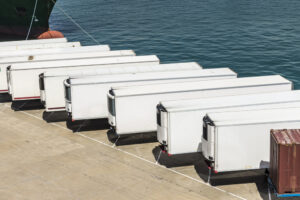Introduction
This guide delves into the complex ecosystem of semi-truck trailers, crucial to the global logistics network, by unraveling the specific designs and functions of various trailer types designed for distinct transportation needs. It emphasizes the importance of understanding legal weight limits, vital for ensuring safety and compliance in heavy-haul shipping. Highlighting the significance of choosing the right trailer, it explains how load and weight capacities influence logistical planning and the safe transportation of heavy or oversized loads, aiming to equip logistics professionals with the knowledge to enhance efficiency, safety, and regulatory adherence in freight transportation. For a comprehensive guide to semi-truck trailers check out our blog!
Trailer Versatility in the Trucking Industry
Dry Van Trailer
Dry van trailers are engineered to offer a protective shell against the elements with an enclosed trailer, ensuring the safe transit of items ranging from electronics to clothing. However, it’s essential to consider the gross weight and cargo weight constraints when utilizing these trailers. Gross weight encompasses the combined weight of the trailer, including the cargo and the trailer itself, while cargo weight refers solely to the load being transported. Adhering to these weight limits is crucial for safe and legal transportation.
In the United States, the maximum gross weight for a semi-truck trailer, including a dry van, is typically limited to 80,000 pounds by federal regulations. This limit is set to ensure the safety of bridges and roads from the potential damage caused by excessively heavy vehicles. The weight regulation is the sum of the tractor weight, the trailer weight, and the cargo weight. Individual states may have specific regulations and allowances, such as permits for heavier loads under certain conditions, but the 80,000-pound federal limit is a standard benchmark. Operators need to distribute the cargo weight evenly within the trailer to maintain balance and stability and to comply with axle weight limits, which dictate how weight is distributed across each axle of the vehicle. Non-compliance with these regulations can result in fines, vehicle impoundment, or other penalties.

Flatbed Trailers
Venturing into the specialized domain of flatbed trailers unveils a realm where functionality meets versatility, particularly suited for the conveyance of oversized freight and heavy-duty cargo. Among the array of flatbed configurations, three distinct variants stand prominently: the step deck, the extendable double drop trailers, and the standard double drop trailer. The step deck, with its unique tiered design, adeptly accommodates cargo that exceeds standard height limits without necessitating additional permits. The extendable flatbed, a testament to ingenuity, offers the flexibility to elongate its bed, making it an ideal choice for transporting exceptionally long items. Yet, it is the standard double drop trailer, with its remarkable central depression, that excels in hauling loads that challenge vertical constraints, making it an indispensable asset in the flatbed category.
The science of loading cargo onto a flatbed trailer transcends mere arrangement; it is a critical endeavor that underpins the safety and integrity of the transport process. This task is intricately governed by the principles of axle weight limits and the overarching concept of gross vehicle weight. Axle weight limits are crucial in distributing the cargo’s weight evenly across the trailer, preventing undue stress on the vehicle and the infrastructure it traverses. The gross vehicle weight, encompassing the cumulative mass of the trailer, its cargo, and the towing vehicle, is meticulously regulated to not exceed the maximum gross vehicle weight standards. This stringent adherence not only ensures compliance with legal frameworks but also fortifies the safety and efficiency of the transport operation.
The standard double drop trailer, with its specialized design for accommodating height-challenging cargo, operates within the strict confines of these regulatory parameters. Observance of axle weight limits is paramount in safeguarding roadways and prolonging the trailer’s service life, while meticulous attention to the gross vehicle weight guarantees that each journey adheres to the highest standards of safety and regulatory compliance. In the expansive landscape of flatbed transportation, each trailer variant plays a pivotal role, yet the standard double drop trailer often emerges as the linchpin for transporting particularly challenging loads, ensuring their safe and secure delivery through meticulous planning and professional execution.

Refrigerated Trailers (Reefers)
Refrigerated trailers, or ‘reefers,’ play an indispensable role in the trucking industry, particularly within the food and pharmaceutical sectors. These sophisticated mobile units are engineered with advanced refrigeration technology, ensuring that perishable goods are maintained at precise temperatures throughout their journey. This delicate equilibrium between temperature control and the efficient utilization of cargo space is pivotal in preserving the integrity and quality of temperature-sensitive products. The technology that underpins reefers is a marvel of modern logistics, incorporating cutting-edge thermal insulation, refrigeration units, and temperature monitoring systems to provide a stable environment, even in the face of external temperature fluctuations.
The design and operation of reefers, however, are subject to the critical interplay of trailer dimensions, weight distribution, and legal axle weight limits. The dimensions of the trailer dictate the available cargo space, influencing how goods are organized and secured. Too much weight or improper weight distribution can compromise the trailer’s stability and maneuverability, posing risks not only to the cargo but also to road safety. Furthermore, adherence to legal axle weight limits is non-negotiable, ensuring that the vehicle remains within legal operating standards to avoid penalties and maintain road infrastructure integrity.
Navigating these constraints requires a meticulous approach to loading and weight management within reefers. The trucking industry professionals must balance the need for maximum refrigeration efficiency with the imperatives of optimizing cargo space and adhering to weight regulations. This balance is critical in ensuring that reefers continue to serve as the lifeline for industries reliant on the transport of perishable goods, delivering products safely and efficiently while upholding the highest standards of quality and compliance. In this complex equation, every cubic foot and every pound must be accounted for, showcasing the expertise and precision that define the modern refrigerated transport sector.
Specialized Trailers
The world of freight transportation is complex, and specialized trailers are custom-made solutions designed to meet specific cargo needs. These trailers range from sleek tankers that safely transport liquids to robust lowboys used for hauling heavy machinery, showcasing the trucking industry’s ability to adapt and innovate. This article delves into the unique characteristics of specialized trailers, focusing on effective loading methods and the importance of managing weight to ensure safe and compliant transport.
Straight loading is a method valued for its efficiency, ideal for the specific requirements of specialized trailers. It involves carefully placing and securing cargo to use space wisely and keep within weight limits. Paying close attention to these details is crucial, as exceeding weight limits can lead to safety risks and legal issues, including fines.
The collaboration between specialized trailers and their matching semi-tractors is a testament to engineering skill, requiring a perfect match between the tractor’s power and the trailer’s cargo needs. This careful selection is vital for the safe and efficient transport of specialized goods, highlighting the importance of a deep understanding of these advanced transportation solutions. Exploring specialized trailers reveals how their design, loading techniques, and weight management play a key role in the safe, efficient, and rule-compliant transportation of various cargo types, emphasizing their critical role in the global logistics chain.
Conclusion
Mastering the diverse world of semi-truck trailers is essential in the logistics industry, where each trailer type, from the versatile dry vans and specialized flatbeds to temperature-controlled reefers and custom-designed specialized trailers, plays a crucial role in the safe and efficient transportation of goods. This guide underscores the importance of understanding specific design features, weight limits, and operational requirements to navigate the complexities of freight transportation effectively. It highlights the delicate balance between maximizing cargo capacity and adhering to safety and legal standards, emphasizing meticulous planning, knowledge, and compliance as key to maintaining the integrity of the global supply chain. Through continuous learning and adaptation, logistics professionals ensure the seamless movement of goods, supporting economies and connecting markets worldwide.







